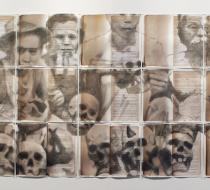The Chronicles of Resilience Favorite
For FX Harsono, art is activism. Over the past four decades, performance, sculpture, and painting have become his means of nonviolent protest against government autocracy and ethnic strife in Indonesia. In his current exhibition The Chronicles of Resilience, curated by Leeza Ahmady, at the Tyler Rollins Gallery, New York, Harsono pays homage to the massacre of his own Chinese minority community between 1947–49, prior to Indonesian independence from the Dutch colonizers in 1949. From the very first influx of Chinese immigrants in Indonesia to the country’s recent torching of Chinese businesses in 1998, Chinese have been long targeted by native Indonesians. In his work, Harsono revives Chinese identity in the region by reprising lost history, archival records, and suppressed memories.
Hardly known in the US, but well-established in Southeast Asia, Harsono’s art uses archival materials to realize the atrocities of history. For instance, in “Memorandum of Inhumane Acts” (2016), there are 33 pieces of digital prints of documents filed by the Chinese, titled “Acts of Violence and Inhumanity Perpetrated by Indonesian Bands on Innocent Chinese Before and After the Dutch Police Action was Enforced on July 21, 1947,” that Harsono found during his research in the Netherlands. Over these documents, Harsono has made graphite and charcoal drawings of Chinese people from the era (inspired by photographs taken by the artist’s father and others from the community) surrounded by and holding exhumed skeletons. Spread out over the length of a wall, Harsono’s sepia-toned digital prints, combined with the spectral drawings, make his palimpsest come alive. Similarly, in “Rewriting on the Tomb” (2013), which hangs alongside the single-channel video “Pilgrimage to History” (2013), Harsono rubs Chinese characters from tombstones in memory of the deceased. Described as “a form of national expiation and healing,” the act of rubbing for Harsono is also reminiscent of the Korean artist Do Ho Suh’s performative rubbings of his apartment and personal objects as a way of instilling memory and identity. Like Suh, Harsono’s highly aesthetic process makes his columns of red characters appear like elaborate embroidery from afar. Resembling quilts replete with lost memory, Harsono’s visually appealing objects resonate long after the viewing.
Without being overly heavy-handed, Harsono’s empowerment of a discriminated minority in his country opens up a larger conversation on exclusion and nationalism around the world, making his activist practice particularly relevant in the current climate fraught with renewed ethnic violence.








